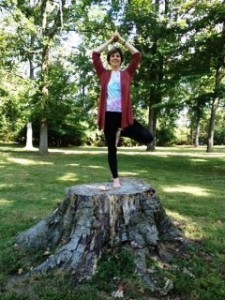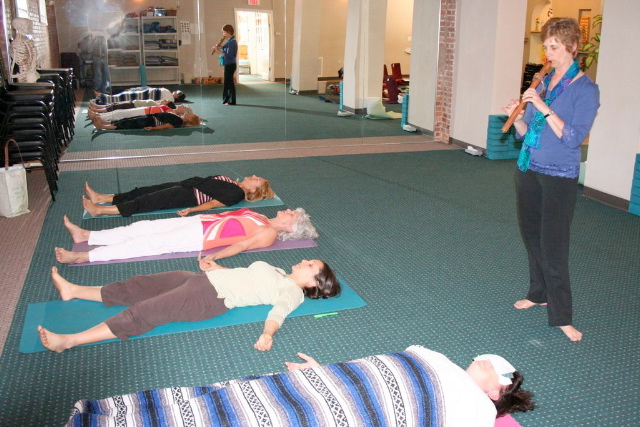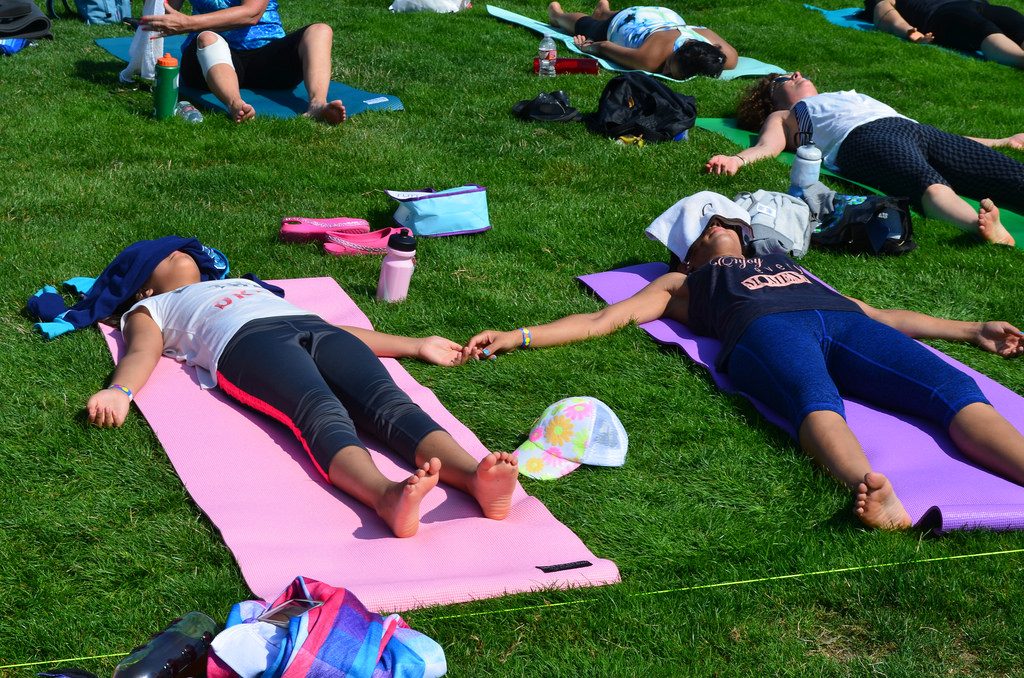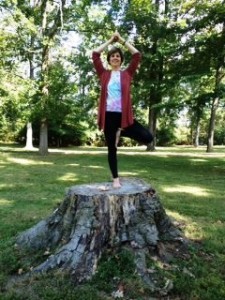Can something as mysterious as Yoga include guided relaxation and imagery?
Excerpted from Yoga Meditations by Julie Lusk

Julie Lusk stumped.
Mayo Clinic’s “Housecall” has discussed the benefits of Yoga. Reading their article reminded me of Julie Lusk, one of our authors who writes about relaxation techniques and yoga. She is a Yoga Master and teacher in the Cincinnati area. Julie can be found at Wholesome Resources when she isn’t traveling, speaking, and teaching. In an excerpt from her book Yoga Meditations she writes about using Shavasana, a yoga pose, to enhance relaxation and meditation.
Guided Relaxation: Still Yoga.
Yoga is the settling of the mind into stillness.
Our essential nature is usually overshadowed by mental activity.
The five types of mental activity are understanding, misunderstanding, imagination, sleep, and memory.
They may or may not cause suffering.
Yoga Sutra 1.2, 1.4-6
Stillness. What a treasure in a world that moves at lightning fast speed. Thankfully, there is an ongoing place in each of us that is an unending reservoir of inner strength and stillness. The purpose of yoga and practices like it is to uncover this powerful core and to use it as a solid platform from which to encounter the world and experience life.
Settling mental activity by actively becoming relaxed and centered is an easy starting point for discovering inner peace; it is also the foundation for most mind-body practices. It actively increases our capacity to calm the mind, soothe the emotions, and open the heart.

Shavasana – Photo used with permission of Julie Lusk
Shavasana (sha-VAH-sah-nah) – the proper supine position for relaxation and guided imagery. The optimal position for guided relaxation and imagery is called Shavasana (sponge or corpse pose) in yoga. Shavasana is done lying down on a firm, flat surface, such as a carpeted floor or mat. A sofa or bed can be used; however, you risk falling asleep if it is too comfortable.
Here are the specifics:
Lie down on a carpeted floor or mat. Feel free to cover yourself with a blanket for warmth.
Start with a nice big stretch. Next, take in a deep breath and sigh it out through an open mouth.
Close your eyes or keep them barely open. An eye pillow or folded washcloth placed over the eyes helps the brain and body relax further.
Place your legs straight out with your heels twelve to twenty-four inches apart. Find a good distance for your feet so that your hips and back can relax. If your back is uncomfortable, bend your knees and lean them against each other with your feet placed on the floor below them. Start by placing your feet wider than your hips, and notice if it feels comfortable and stable. If not, adjust the placement of your feet and knees. An alternative is to place a sturdy pillow or bolster under your knees. Take the time you need to find the optimal position for your comfort.
Lift your hips up slightly and place them back down so they fall supported and your weight is evenly distributed.
Draw your shoulders downward by gently lowering them toward your ears. Snuggle and tuck them in so they rest comfortably beneath you.
Stretch your arms out and away from your sides in a position of ease. Place your palms face up and notice how this feels to you. If you prefer, turn your palms down or place them on your body.
It is important to preserve the natural arch at the back of your neck. To do so, rest the back of your head on the floor and make sure that neither your forehead nor chin is higher than the other. You may use a small pillow under your head, or roll up a small towel and place it under your neck.
Let your awareness roam around your body to become aware of any area that may be uncomfortable and take the time needed to adjust your clothing and your posture so you are totally at ease.

Shavasna
Now you, or your clients, are in the perfect position to enjoy meditation or guided imagery. Find a CD with images you and your clients will find soothing, beginning with shorter scripts (5 to 8 minutes) and then graduate to longer ones when you have mastered relaxing for 5 minutes or so. You will find it gets easier each time the routine is practiced.
Remember that your clients are learning what might be a brand new way of using their muscles. Just as it takes time to learn to be a great shot on the basketball court or to be able to play perfect arpeggios on the piano, it takes time and practice to become expert at relaxation and yoga techniques. Everybody take a deep breath and begin to explore a new way to relax.
Go here for a selection of relaxation and guided imagery CD’s.


